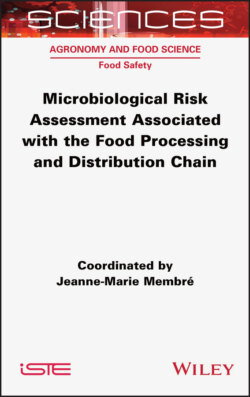Читать книгу Microbiological Risk Assessment Associated with the Food Processing and Distribution Chain - Jeanne-Marie Membre - Страница 25
1.4. An example of the use of data in hazard identification, exposure assessment and risk characterization
ОглавлениеThe example developed below is based on the work of Membré et al. (2015) on canned foie gras.
Non-acidic canned items require the application of thermal processing to render them healthy, safe and atmospherically stable. The preparation of canned food involves placing the foodstuffs into packaging that is impermeable to gases, liquids and microorganisms, then heating them to a temperature above 100 °C for a variable period of time depending on the food. The temperature charts (time–temperature relationships) that have been used for decades have usually been defined empirically, with the sights set on the main microbiological hazard associated with the manufacture of canned food, proteolytic Clostridium botulinum, a sporulating anaerobic mesophilic bacterium (Frazier 1967; Stumbo 1973).
It is generally accepted that a treatment equivalent to at least a temperature of 121.1°C for three minutes (conferring a sterilizing value of three minutes) allows an inactivation of an order of magnitude of 12 log of proteolytic C. botulinum spores, and this is the standard for the thermal processing of low-acid foods that are ambiently stable. However, some canned products with an excellent safety history receive a heat treatment below this three minute sterilization value.
For example, the microbiologically safe processing of canned nitritated charcuterie (pâté) relies on mild thermal processing in combination with the presence of nitrite salt in the formulation in order to prevent the growth and formation of toxins from a low level of spores (Anderson et al. 2011). Similarly, despite being subject to fairly mild thermal processing, canned foie gras has a proven safety record: no cases of botulism attributed to this product had been reported in the 10 years prior to the study in France (INVS 2013), where 90% of France’s output is sold, and moreover, no cases had been reported in the literature (Internet search on www.promedmail.org, www.eurosurveillance.org, www.ncbi.nlm.nih.gov/ and archive.org, which documented more than 700 cases of food botulism from 1918 to 2013).
However, epidemiological data do not provide sufficient evidence to draw firm conclusions on food safety. The authors of the study therefore decided to build a quantitative microbial risk assessment model in order to assess the potential risk associated with proteolytic C. botulinum in canned foie gras.
In order to estimate the initial level of contamination of raw foie gras at the stage of their exposure assessment, they used data from manufacturers. Sampling was carried out over nine months with the help of 14 French companies representative of various scales of canning operations. Three hundred and seventy-two raw foie gras samples were taken just before sterilization; they were frozen and sent to the laboratory for analysis. A specific direct count of C. botulinum not being possible, a series of steps were carried out. First of all, the count of bacteria forming anaerobic spores was carried out according to the French standard NF V 08-602 (AFNOR 2011) with one modification (a change in the processing temperature). Only the black colonies were counted because they correspond to the Clostridium type. Identification involved partial sequencing of the coding region of 16S rRNA. Finally, for all isolates identified as C. sporogenes or C. botulinum, specific identification of the C. botulinum genes was carried out according to a variety of protocols (Raphael and Andreadis 2007; Fach et al. 2009; Woudstra et al. 2012).
To estimate the level of risk affecting the French population and to use that to validate the estimated level of risk during the study, epidemiological data covering the period 2001–2012 were collected and analyzed. In France, information on botulism epidemics is compiled each year by the National Institute for Public Health Surveillance (INVS 2013). The data for the 12 years were extracted and then analyzed to estimate the number of cases per million inhabitants in France.
The quantitative risk assessment model estimated, with current consumption, an average probability of illness of 8.0 x 10 -10 per inhabitant and per year. This value is very low, which led to the conclusion that current practices in terms of the thermal processing of canned foie gras were sufficient to control the risk of the presence of C. botulinum in foie gras in France.
It is worth noting here that this study was supported by the Comité Interprofessionnel des Palmipèdes à Foie Gras, a body that brings together all professional stakeholders in the sector. It was carried out by scientists from the academic and professional spheres, not by health authorities. This supports what was mentioned in section 1.2: hazard identification and risk assessment are tools that can be used by a wide-ranging scientific community.
